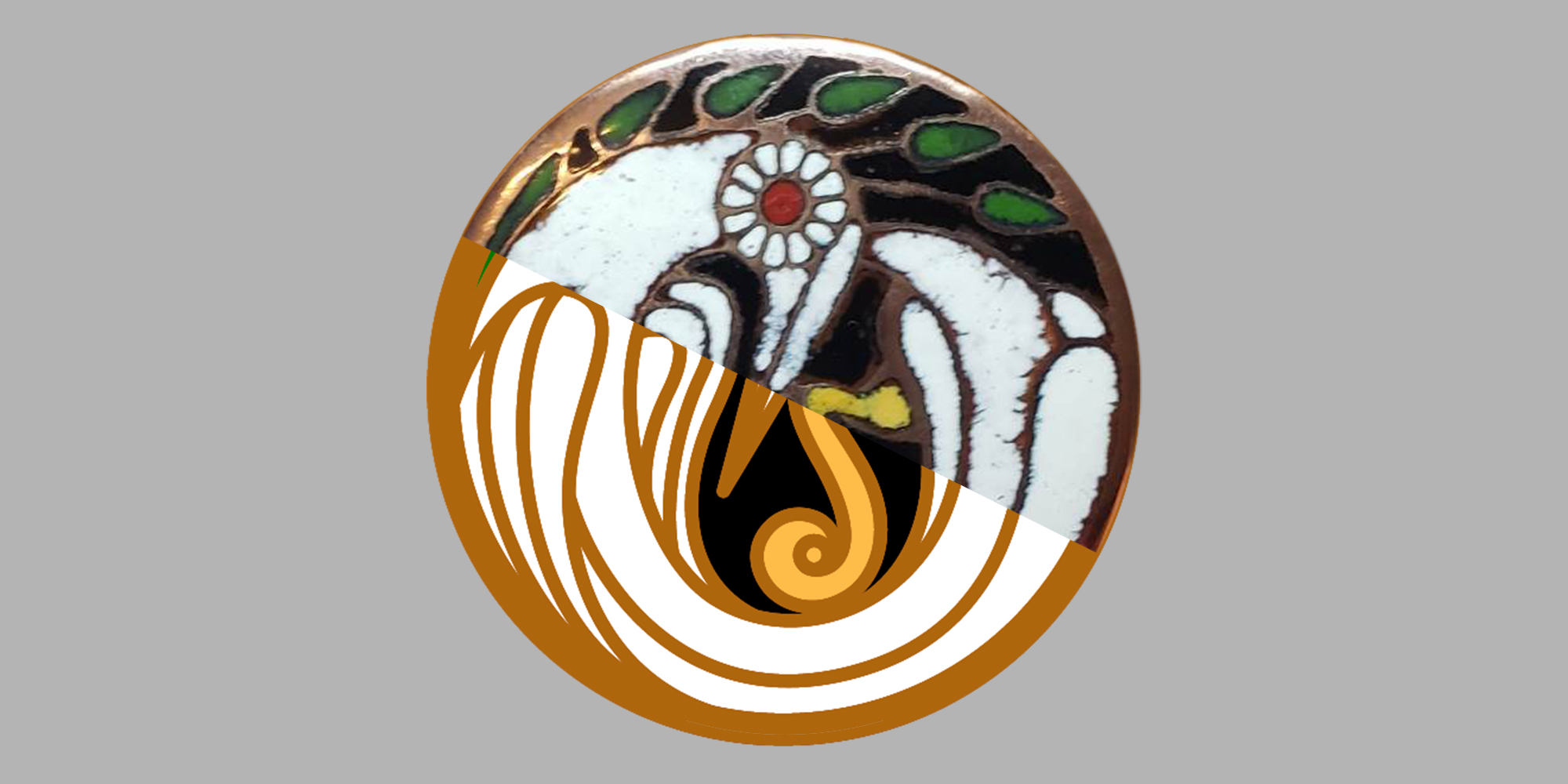I was so happy for the chance to design the medallion for Lanea inghean Uí Chiaragáin’s elevation to the Order of the Pelican, and the additional opportunity to create a necklace from which to hang it. Final enameled medallion created by Edgar Refskegg and Sinn Larensdotter.
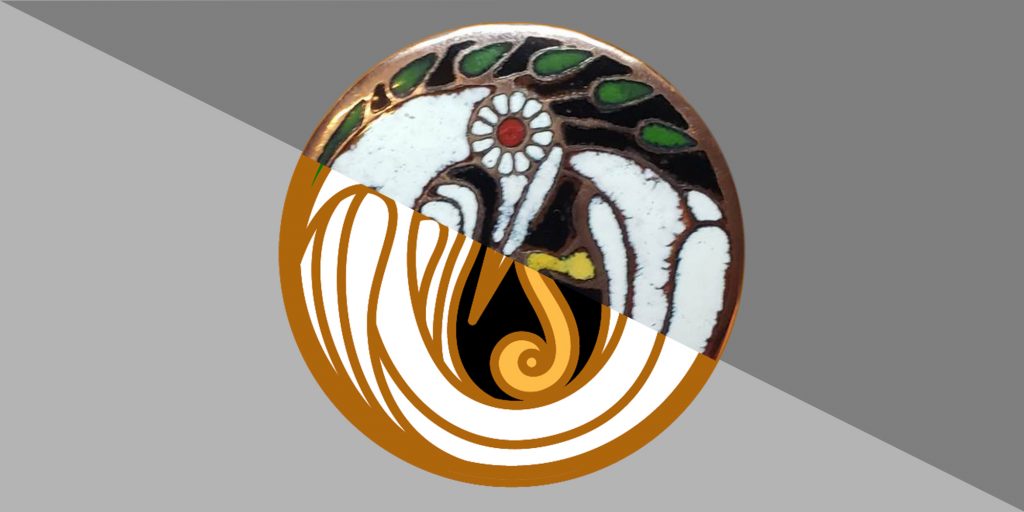
the needs of the design
Design is problem solving.
This piece had many distinct needs. It needed to:
• be produced in champlevé enamel
• portray a Pelican
• integrate laurel leaves
• represent a Scythian art style
• fit on a 2″ round blank
• coordinate with copper metal
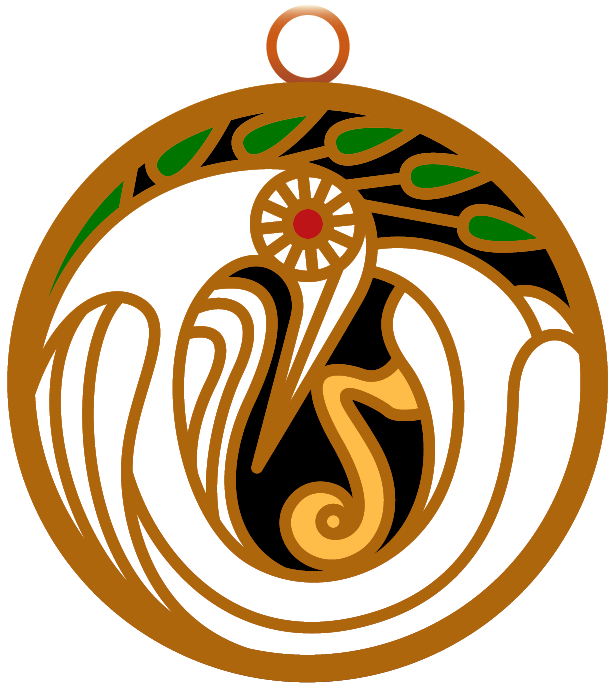
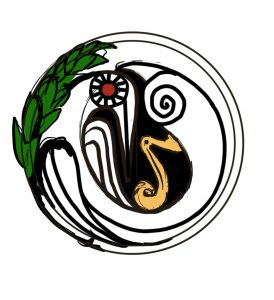
I knew going in that Lanea really likes Scythian art. But Edgar would be creating a medallion using champlevé enameling, and the Scythian design sources I was looking at all were lost wax cast sculptures or chased/repoussé reliefs, which meant an change from three-dimensional to two-dimensional designs.
I needed to make some adjustments.
remediation
In their 2000 book “Remediation: Understanding New Media”, Bolter and Grusin argue that the term remediation describes “the way in which one medium is seen by our culture as reforming or improving upon another”1. Rather than simply an extension of the word “remedy”—as in, bringing remedial studients up to scratch, or remediating a damaged ecosystem—their definition is one of medium as well as improvement. The DVD improved on the cassette tape; the MP3 improved on the DVD. Their remediation describes this process. (Further, there is a push-pull between the proliferation of the new media and its desire to both build upon and erase the fact of the previous incarnation, but that aspect is less relevant here.)
When I have heard the term crop up in discussions within the academic discipline of premodern art history, it’s been simply to describe the translation of an item, artwork, story (or something like that) from one form of media to another…improvement notwithstanding. When a book becomes a film, it has been remediated2.
But.
When I use this term within an SCA context, I’m stretching even further beyond the definitions above, borrowing the terms Bolter and Grusin discuss to address the creative process as well as the experience of viewing. To my perspective and in my experience, SCAdian creative processes entangle the two as they remediate the artwork that came before—whether a matter of improvement, sources, intent, or a combination thereof. And they do so in three ways:
First, SCA works remediate by improvement. It can happen not only technologically (in minimizing danger, effort, etc), or materially (translating into a different medium for reasons including but not limited to cost, affordance, accessibility), but also structurally, because our context demands different things from our art—and sometimes very different things; a scroll is not a page from a book of hours—so we are required to change the previous work to suit us. The original is not fit for purposes. But our amendments make it so.
The second form of remediation is a matter of source.
In their book, Bolter and Grusin discuss three key theories. Remediation is one. Immediacy and hypermediacy are the others. Immediacy describes a viewer’s decreased awareness of the media (think of immersion), while hypermediacy describes a viewer’s active awareness of the media (think of an intentional frame/framework/veil between the viewer and the viewed)3. As creators, our art exists within that same paradigm; we have an unavoidable awareness of its orientation with regard to the past, even as (or whether) we use the item in the present.
This leads to us having a sort of double vision. When the artwork (or item) was made for the first time, its creator saw it with immediacy. They saw it once: that moment, at that time, in that context. They created the work using any number of known or unknown sources, and there are whole schools of research looking into the transmission of design and the evolution of style, but ultimately they were immersed in their own specific context of creation.
For us, on the other hand, our source is different. Their source is their source, but our source is them. When we look at our modernly-created version of that item, are seeing the item through a filter, a filter made from our mental image of that item from the past—our expectations of it, our desires from it—alongside all our personal feelings about the art we made. This is hypermediacy; we see it twice, with awareness of the seeing.
Methinks I see these things with parted eye,
When every thing seems double.
-Hermia, Act IV Scene 1, “A Midsummer Night’s Dream”
Which leads to our third form of remediation: intent.
They made their art/item to serve a purpose, whether that be sacred or fiscal or love or war. We may not know it (and some would say we can never know it; I’m reminded of a recent talk by Mary Beard in which she describes how the most frustrating but wonderful part of studying the Romans is that you will never, ever be able to put yourself perfectly into their perspective, but that gulf between us is what makes the study of them interesting4.) But when we make art, it’s never going to be the same intent. How could it? We are living right now, making art for the SCA. They…were not. Their intent was inextricably entangled with the immediacy of their artmaking. Ours is an attempted conversation with the art of the past, no matter if our final result is a gift or resource or contest entry or simple joy. This difference of intent will affect the artwork itself, often in multiple ways. Theirs was art. Ours is art about art. We’ve remediated by changing the direction of our intent.
so what?
So why this flight of philosophy?
It’s an interesting exploration, for one thing. Why do we make things? How do our activities in the SCA affect what and why we create? How does that relate backward to the past? How can our expectations be realistic? And obviously when I use the word remediation to discuss my process, I want folks not only to know what I mean by the term, but to have a broader understanding why I’m saying it.
But in a deeper sense, I borrow these terms because I hope they help me describe the layered and complex circumstances in which we find ourselves when we create within an SCA context. Absolute repetition is impossible. Our motivations matter. Even if our source is the past, it impacts the present. As such, I want to be acutely thoughtful about the nature of our work, with the hope that this awareness which might also aid us in being thoughtful about our impact in other trajectories, too.
in practice
In order to translate the reference art into an enamel medallion, I would need to collapse three-dimensional art into a fundamentally two-dimensional design. The design would be changed from the media of cast or chased/repoussé metal to the new media of champlevé enamel.
Remediation is “lossy”, however; when speech is converted to text, we lose audible cues such as intonation and volume. In this case it would be particularly so; any features we would have read in the depth are lost in the translation, which makes the placement of line even more important than it would have been originally.
The upside to this loss is the opened door to alternative interpretations. While a potential detriment for internet communication, in this case the freedom afforded by remediation allowed me to more easily integrate a version of the heraldic art required. If not for this translation, I could very well see it being more difficult to adapt.

scythian art
The Scythians were based on the northern shores of the Black Sea, from the seventh to about the third or second centuries BCE5.
Scythian art is fundamentally more abstract than realistic, so this medallion didn’t need to tell a tale of truth. Instead, I could consider the legibility of my intention (pelican, laurel leaves) and the overall aesthetics created by shape and line.
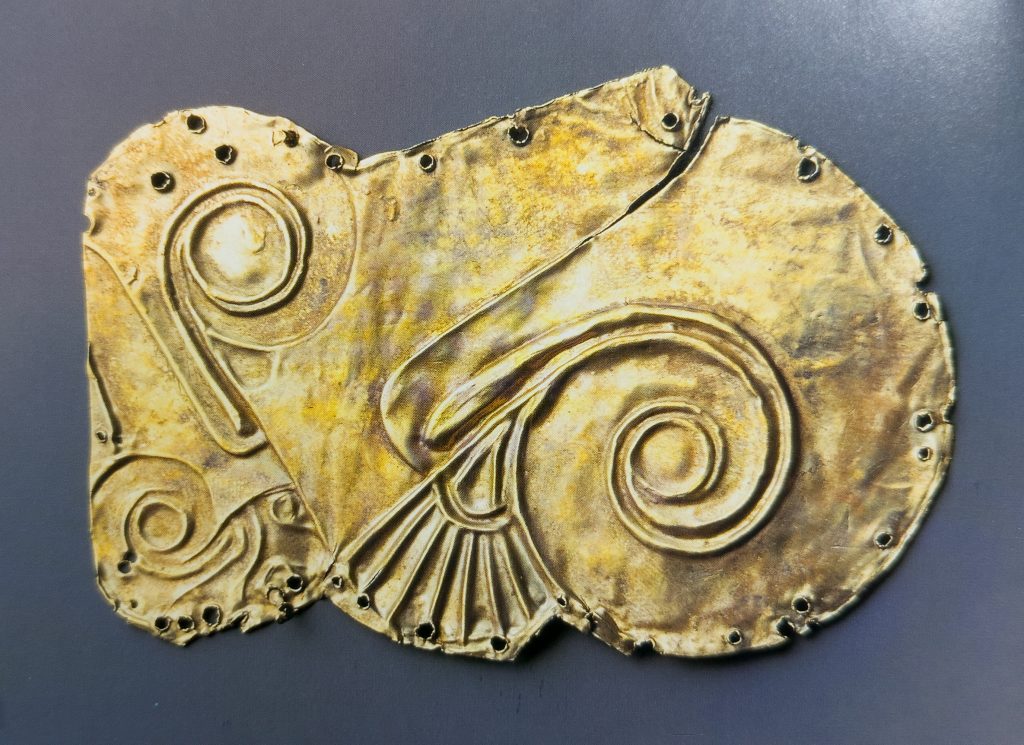
reading symbolism
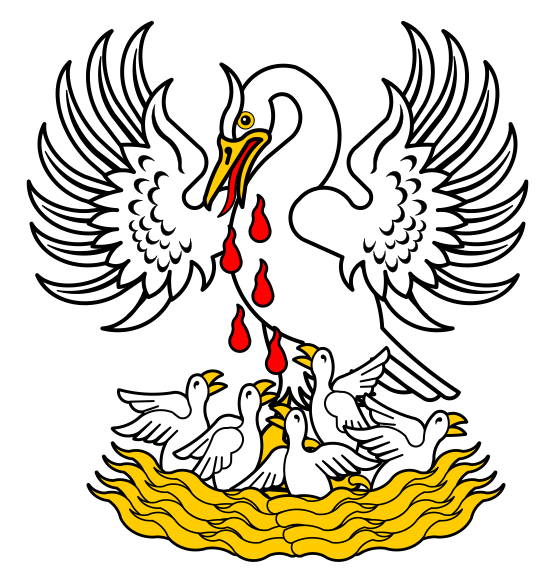
A lot of the legibility is due to color and our heraldic understanding.
One of the reasons heraldry even exists was to quickly convey information, and this is one circumstance where heraldic frameworks are helpful—even if they’re out of period for our current art style. I could integrate the white body and yellow legs, and in this context could be reasonably confident it would read as a heraldic pelican.
I was also confident she wouldn’t mind if I dispensed with another diagnostic heraldic detail, however: the symbolism of bloodying her own breast in service. It neither suited the Scythian (read: non-Christian) source of the design nor Lanea herself.
Instead, I relocated the red into the pelican’s eye, which served as a bright focal point and a gem-like substitute for other materials. (Also it’s a little creepy. Which is a decided asset.)
cultural communication
The bedrock of Scythian territory lay north of the Black Sea, largely across what is now Ukraine. But we think their ancestral homeland was further east in the Altai Mountains, that Central Asian nexus of mountain, forest, and steppe which (much) later produced the Huns and the Mongols. They carried this cultural connection when they migrated westward7.
So when we look at their art in our target period of around the 6th–2nd centuries BCE, we see the ways in which many elements of its style were shared across the Eurasian continent: a demonstration of one way in which culture has been transcending political boundaries for thousands of years.
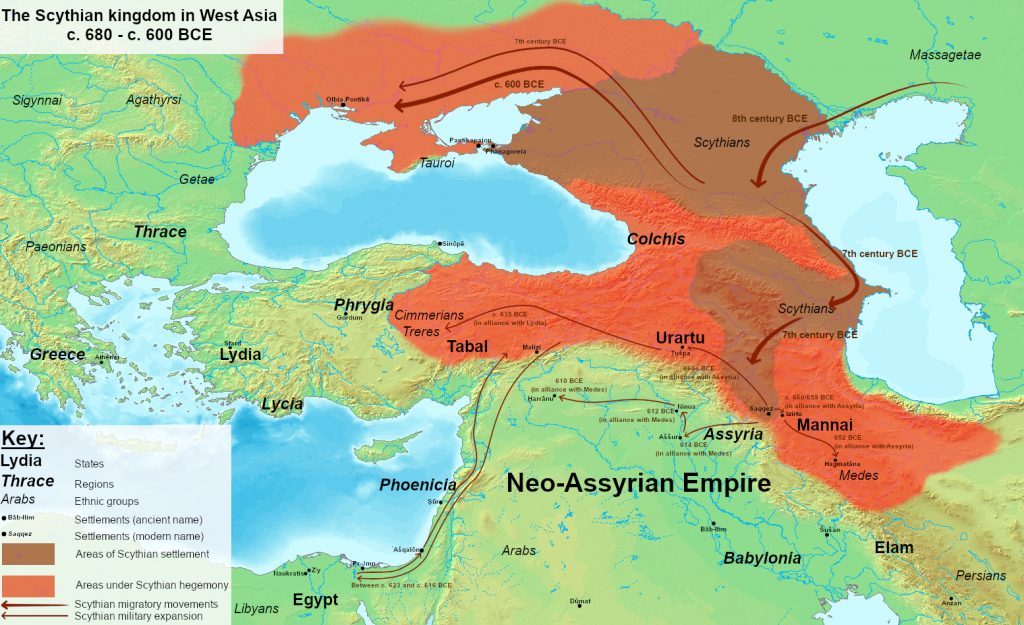
Take the coiled pose of our pelican.
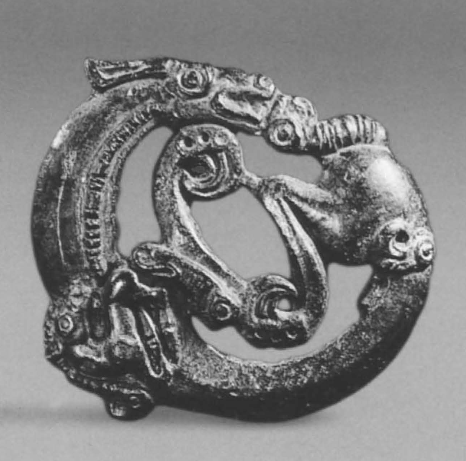
Simferopol, Crimea. Late
6th century BCE8
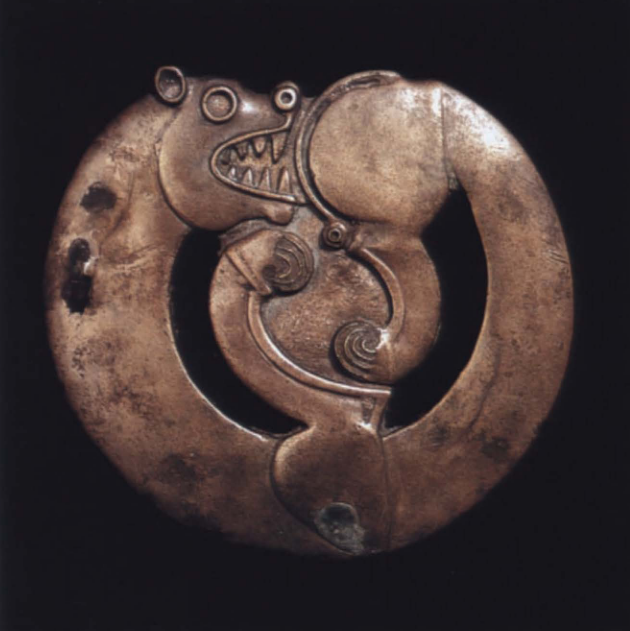
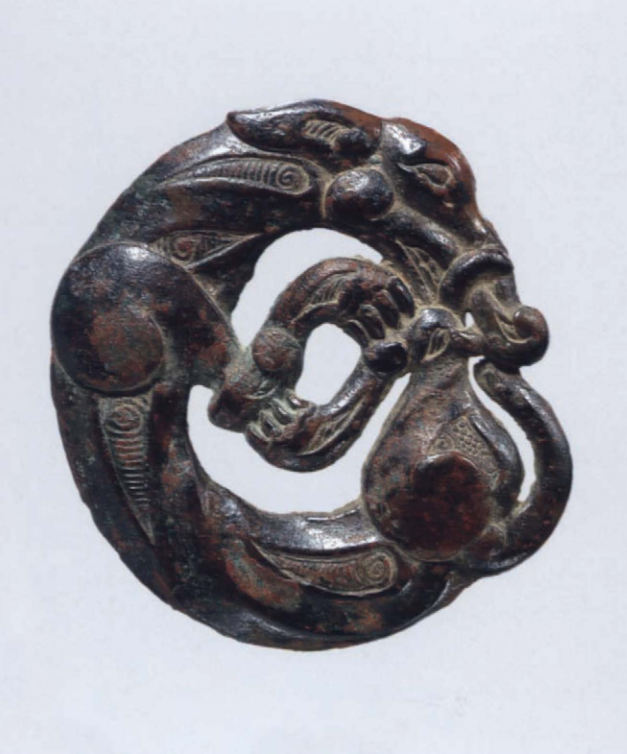
Our pelican (and its foot) were inspired by the late 6th century BCE horse bridle ornament at left, found in Simferopol, Crimea (representing a Black Sea source). See also the 7th–6th century BCE coiled cat bridle ornament from the Tuvan republic (at middle, representing a Central Asian source), and this extremely similar coiled wolf from Northwest China, 5th-4th century BCE (at right, representing our East Asian source). Its pose was originally East Asian, then spread west to Central Asia and beyond11. The coiled animal iconography ties the continent together.
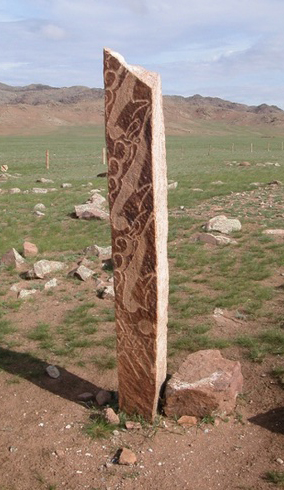
For another example of shared iconography, compare the 1400–700 BCE Mongolian deerstone (at left) with this 4th century BCE pole finial buried in Pokrov, Ukraine (at right)12.
The voluminous volutes (that is to say, spirals) that form the recumbent animal’s antlers draw a handy line across the continent.
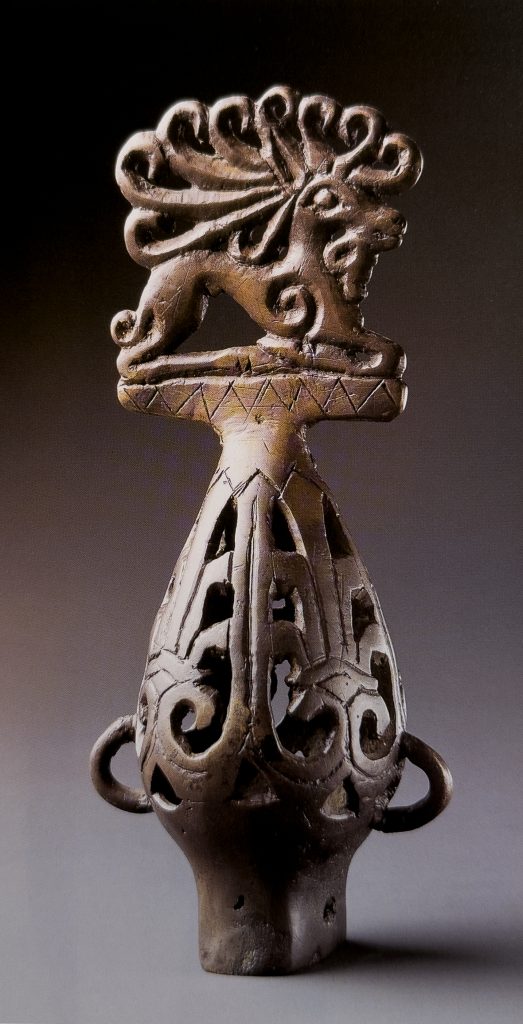
In the 1999 exhibit catalog Scythian Gold, Esther Jacobson writes, “The recumbent deer, the crouched or coiled feline, and the bird or bird head compose what may be called the archaic triad of Scythian imagery”14. To this list, and especially for this two-dimensional purpose, I add the volute. Sometimes they form the terminals of appendages, sometimes they define a shoulder or a jaw (or both, as in the pole finial above), but they are frequent, and in spite of the lack of space I felt I really needed one. Fortunately the foot was right there, ready to bear my spiral and provide a counterpoint for the radial eye.
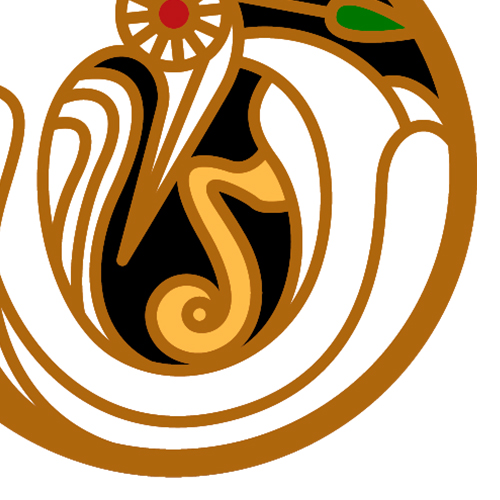
All of which is to say: being able to combine the coiled animal, the bird head (even if I made the decision to keep its beak straight rather than make it coiled, therefore keeping it from looking too much like a raptor), and a volute were all helpful for representing the Scythian style.
focal point
One aspect of Scythian style I was confident would work well in enamel was the striated, textural, rhythmic border of repeated lines.
These bridle ornaments at right are from the 4th century BCE, made in either Ukraine or Bulgaria, during either the Scythian or Thracian periods. The style can be seen repeatedly across both, a commonality not only understandable based on what we’ve already seen from art spanning Eurasia, but because they both take their places around the perimeter of the Black Sea15.
See also the borders on these harness ornaments from Bulgaria, in the Thracian period, below left and center.
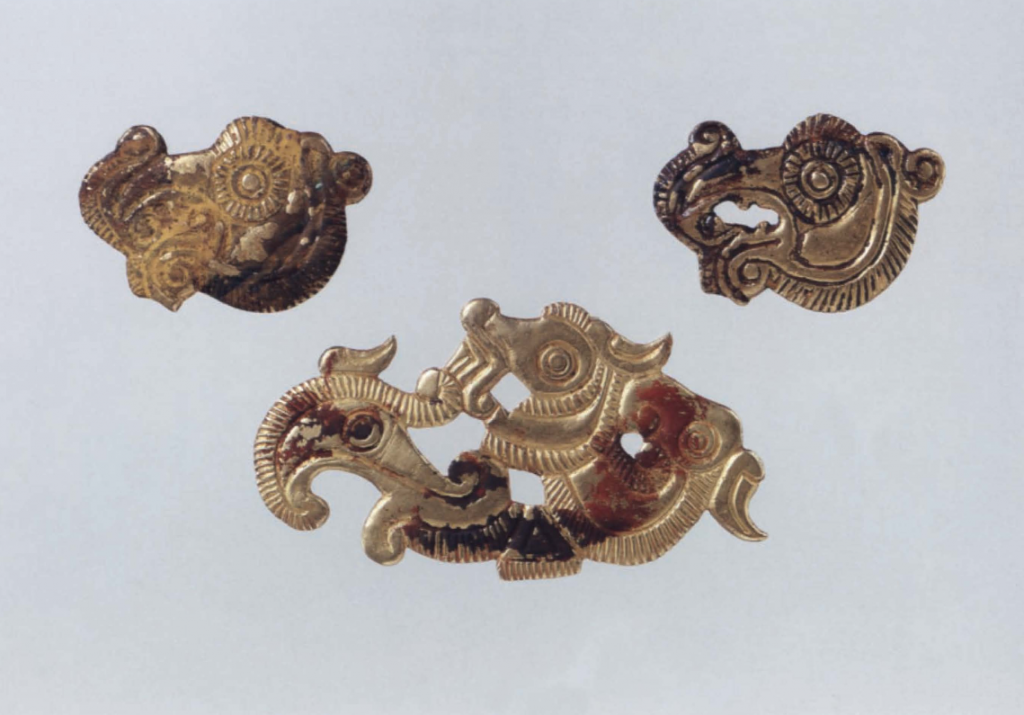
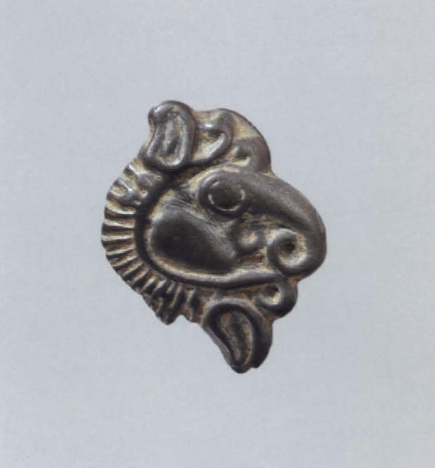
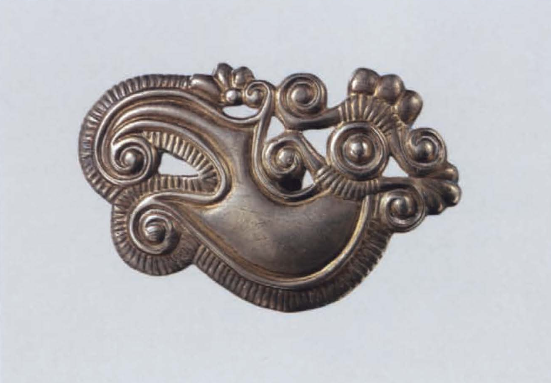
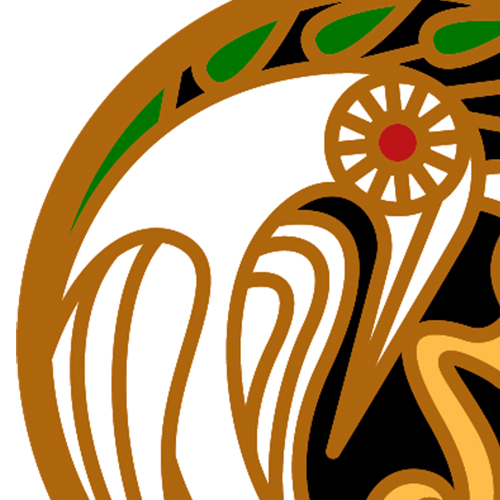
The style is clearly the source of our eye. Radially engraved lines spread from a circular center, creating a compelling wide-eyed stare. (Don’t cross this bird.) Placed along the center line below the bail its treatment is intended to provide a focal point, and as you can tell even from a quick glance over these assemblage of artifacts, it provides a visual thesis statement for the style of the piece.
contours
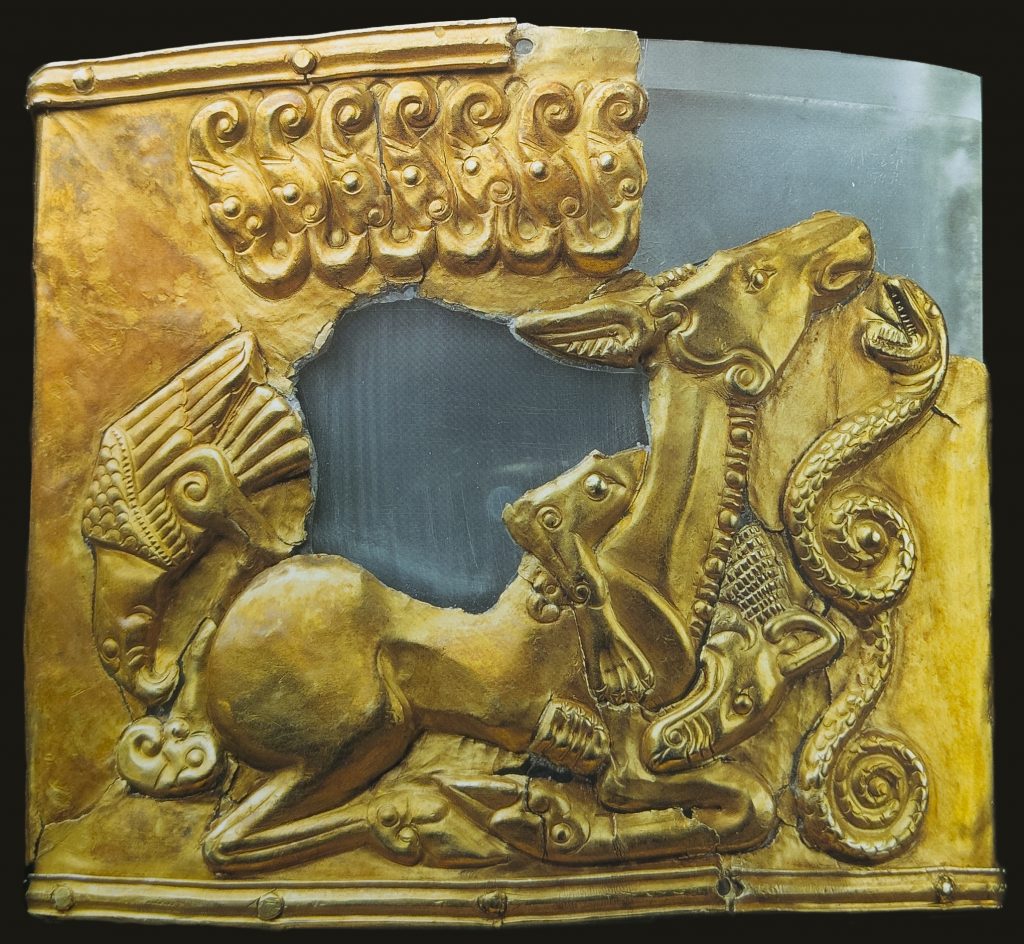
The sideways eagle on the left side this quiver cover provides an ideal demonstration of what a bird should look like in this style. The two blocks of wing feathers and tail are divided by evenly-spaced inscribed lines, each of which follows the direction of the wing (or tail), and the ends of each feather are vaguely blunted.
Early on, I decided that due to the nature of the medium, in order for it to be produceable—and readable—I would need to compromise with the design of the feathers by limiting their number. Fortunately the final design still creates a similar clean and abstract look, and I’d rather have fewer than none at all.
being green
While laurel leaves are mostly self-explanatory and have their own heraldic standard, I could still reference two items: this 2nd–2st century BCE openwork belt plaque from Ningxia, and this 3rd–2nd century BCE belt plaque housed in the State Hermitage Museum. The former is a Xiongnu burial object, and its stylistic relationship to a belt plaque from Western Siberia suggests a western genesis of the Xiongnu, which furthers the narrative of a cross-Eurasian stylistic milieu20.
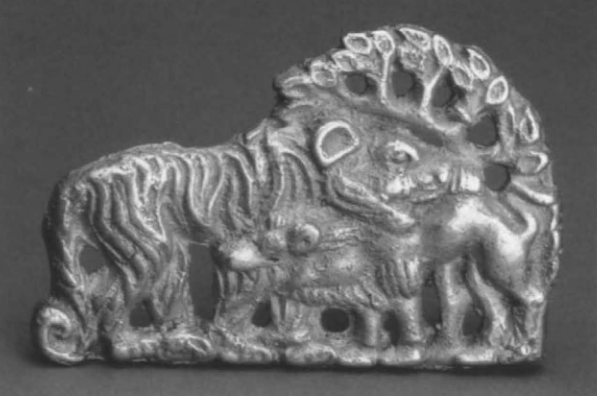
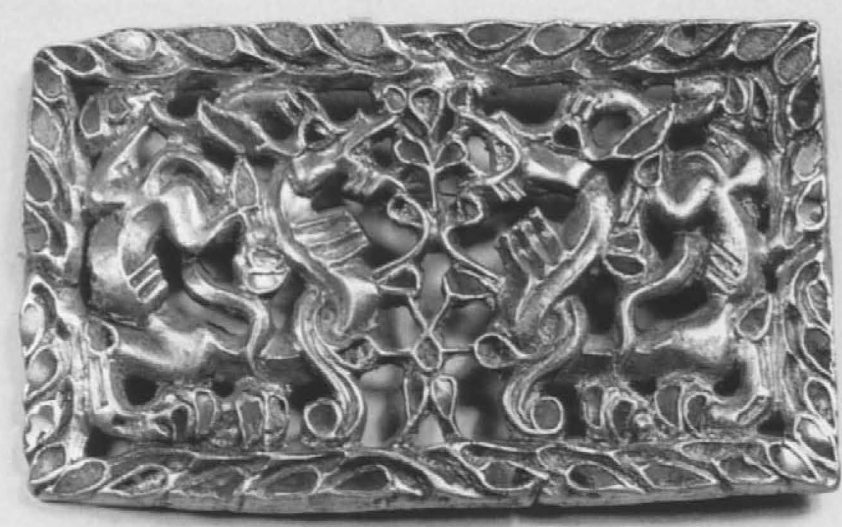
strung out
Lanea requested that the necklace integrate with this torc—made by Roibeard mac Neill—in part because her usual style is firmly Celtic. Considerations included not only aesthetics, but also the logistics of placing it on her during the ceremony.
It would have been too unwieldy (or borderline impossible) to place the whole thing on her at once, so a two part, modular approach seemed most realistic. I decided that the easiest way to do that is to add hooks on the ends, reasoning that either she can be wearing the torc already at the beginning of the ceremony, and the necklace could be attached, or that the whole shebang can be presented and placed upon her at the necessary time. I owe Aelia Suphunibal SO many thanks for rushing me some wirework findings, saving me the wrangling and enabling me to ship the necklace with plenty of time to spare.
For the beadwork itself, my references only showed me modernly-strung options, but I knew I that needed to integrate the copper of the medallion with the silver of the torc alongside the colors of the enamel, and it needed to blend in spirit with the Celticness of her style, so I decided to just dive in with an assemblage that looked good and used likely beads (from my existing knowledge of ancient bead types, including below). I knew the necklaces she tends to make and wear are symmetrical, so I strung it symmetrically as well.
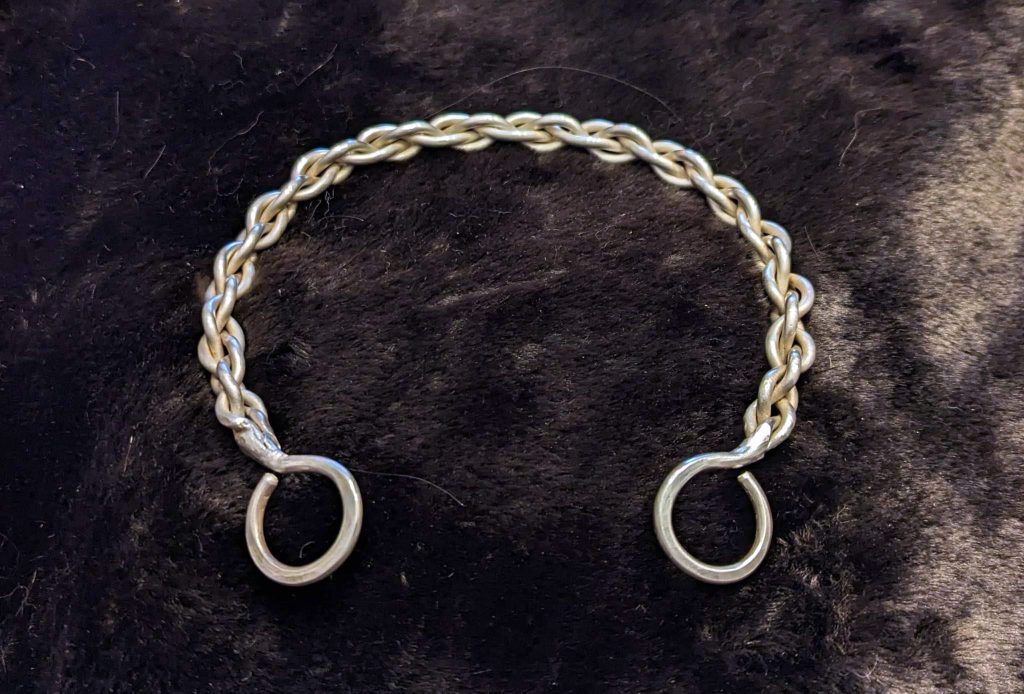
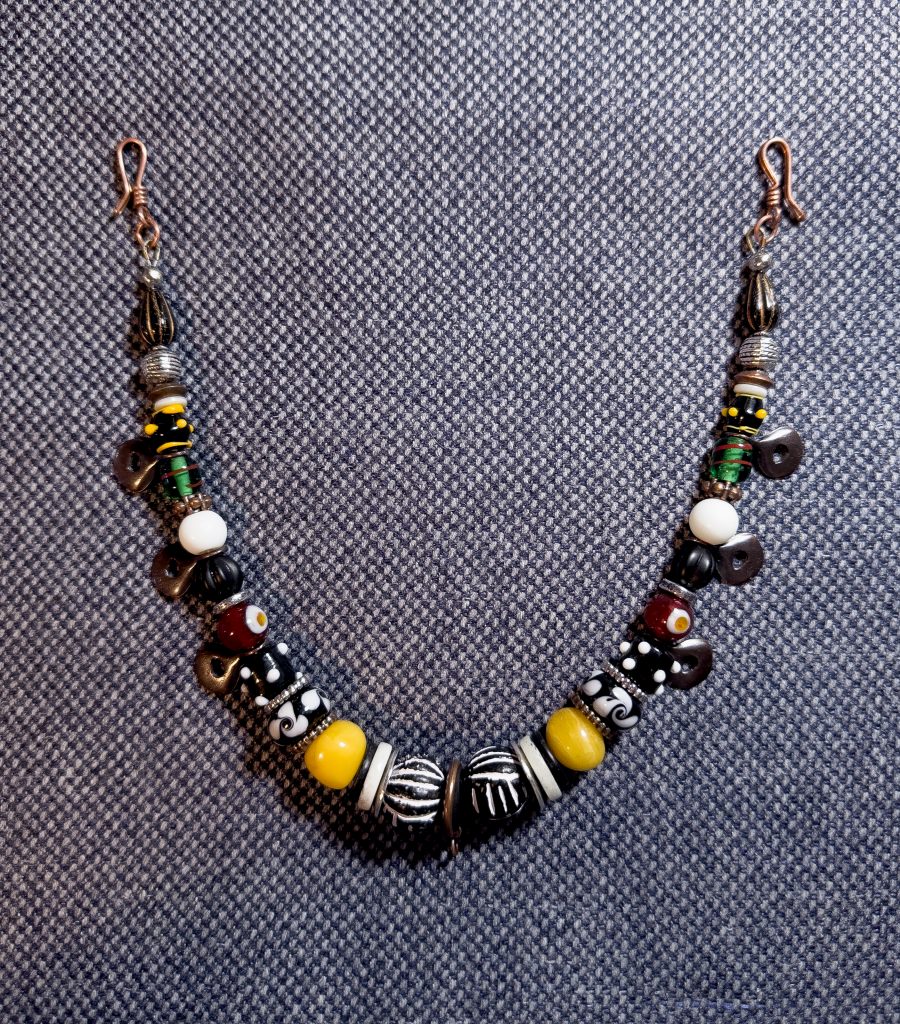
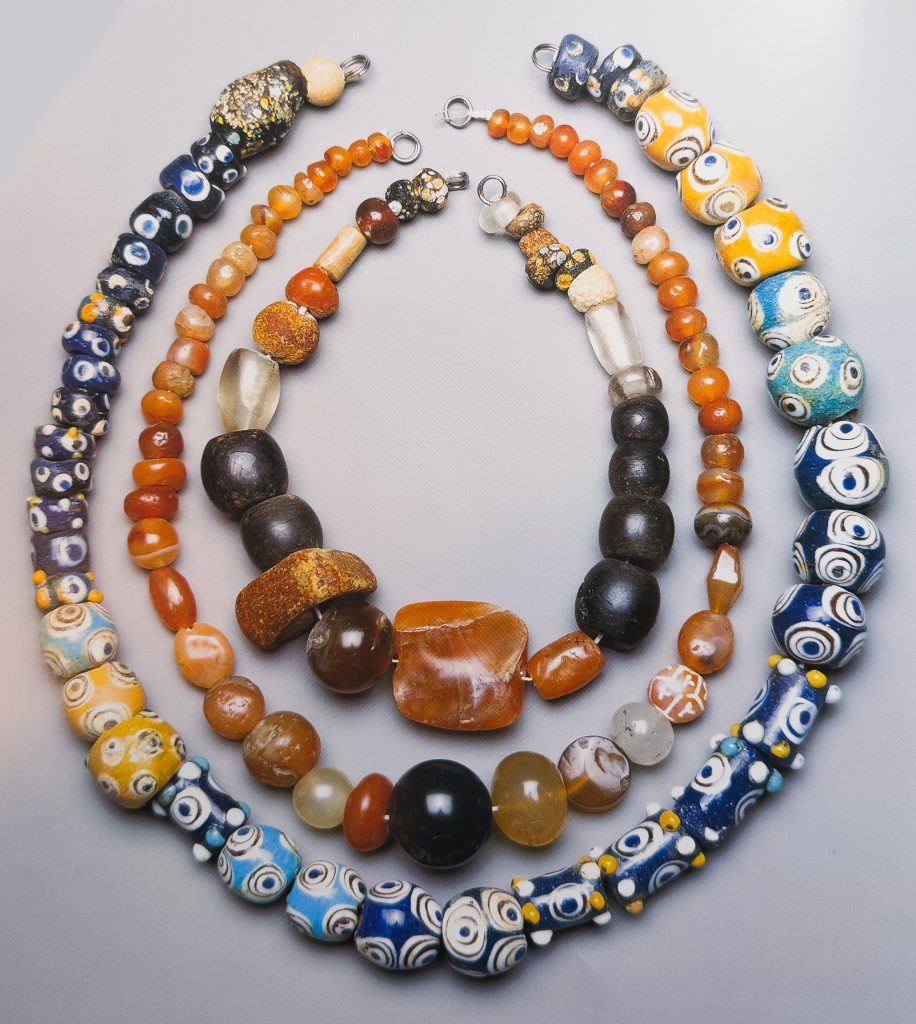
At left is a modern restringing of beads from many 6th–4th century BCE Scythian find spots, made from many materials including glass paste, onyx, agate, carnelian, bone, Baltic amber, sard, sardonyx. chalcedony, with one carnelian carved with honeycomb pattern and inlaid with white.
Lanea’s new necklace is a mix of glass (eye beads! stripes! melons!), butter amber, bone, shell, and metal, including a phalanx of copper amulets which she can attach things to if and when she wants to. I think it represents a decent span of place and time, exactly the way it was intended.
and finally
I am grateful to Edgar, not only for working with me on this extremely fun project, but for being willing to put a bail on the back, allowing me to design for the entire medallion surface without having to leave room for a hole. (With the leaves, it would have been…tricky.) Thanks to Sinn, for throwing in her lot in the medallion maker mines. And once again, thank you to Suphunibal for the gorgeous hooks. (She’s so good.)
It takes a village to decorate a Pelican.
And on that note, it only remains for me to express my delight that Lanea is being honored in this way. She works SO hard, and I’m incredibly glad that people have seen her for it. Congratulations, friend.

notes
[1] Jay David Bolter and Richard Grusin, Remediation: Understanding New Media (Cambridge, MA: The MIT Press, 2000), 59.
[2] Ramey, among others. Lynn Ramey, “Immediacy, Hypermediacy, and New Media in The Secret of Kells (Moore 2009),” Medieval Perspectives, January 2014: 2, https://www.researchgate.net/publication/282909026_Immediacy_Hypermediacy_and_New_Media_in_The_Secret_of_Kells_Moore_2009.
[3] Bolter and Grusin, Remediation, 5–15.
[4] Mary Beard, “What Can We Learn from the Classics: A Piece of Cake,” filmed April 20, 2023 for Berlin Family Lectures, University of Chicago, video, 1:07:00, https://www.youtube.com/watch?v=syBsHD9fiAY.
[5] Ellen D. Reeder, Scythian Gold (New York: Harry N. Abrams, Inc.1999), 23.
[6] Reeder, Scythian Gold, 164.
[7] Reeder, Scythian Gold, 37.
[8] Emma C. Bunker, Nomadic Art of the Eastern Eurasian Steppes (New York: The Metropolitan Museum of Art, 2002), 24.
[9] Bunker, Nomadic Art, 25.
[10] Bunker, Nomadic Art, 45.
[11] Bunker, Nomadic Art, 24.
[12] Reeder, Scythian Gold, 140, 142.
[13] Reeder, Scythian Gold, 142.
[14] Reeder, Scythian Gold, 61.
[15] Bunker, Nomadic Art, 46–47, 49.
[16] Bunker, Nomadic Art,49.
[17] Bunker, Nomadic Art, 46.
[18] Bunker, Nomadic Art,47.
[19] Reeder, Scythian Gold, 160.
[20] Bunker, Nomadic Art, 31.
[21] Bunker, Nomadic Art, 33.
[22] Bunker, Nomadic Art, 32.
[23] Reeder, Scythian Gold, 170.
bibliography
Aruz, Joan and Ann Farkas, Elisabetta Valtz Fino, and Metropolitan Museum of Art. The Golden Deer of Eurasia; Perspectives on the Steppe Nomads of the Ancient World. New York, New Haven: Metropolitan Museum of Art, Yale University Press, 2006.
Bolter, J.D., and R. Grusin. Remediation: Understanding New Media. Cambridge, MA: The MIT Press, 1999.
Bunker, Emma C., Nomadic Art of the Eastern Eurasian Steppes. New York: The Metropolitan Museum of Art, 2002.
Ramey, Lynn. “Immediacy, Hypermediacy, and New Media in The Secret of Kells (Moore 2009).” Medieval Perspectives, January 2014, 109–20. https://www.researchgate.net/publication/282909026_Immediacy_Hypermediacy_and_New_Media_in_The_Secret_of_Kells_Moore_2009.
Reeder, Ellen D. Scythian Gold. New York: Harry N. Abrams, Incorporated,1999.

